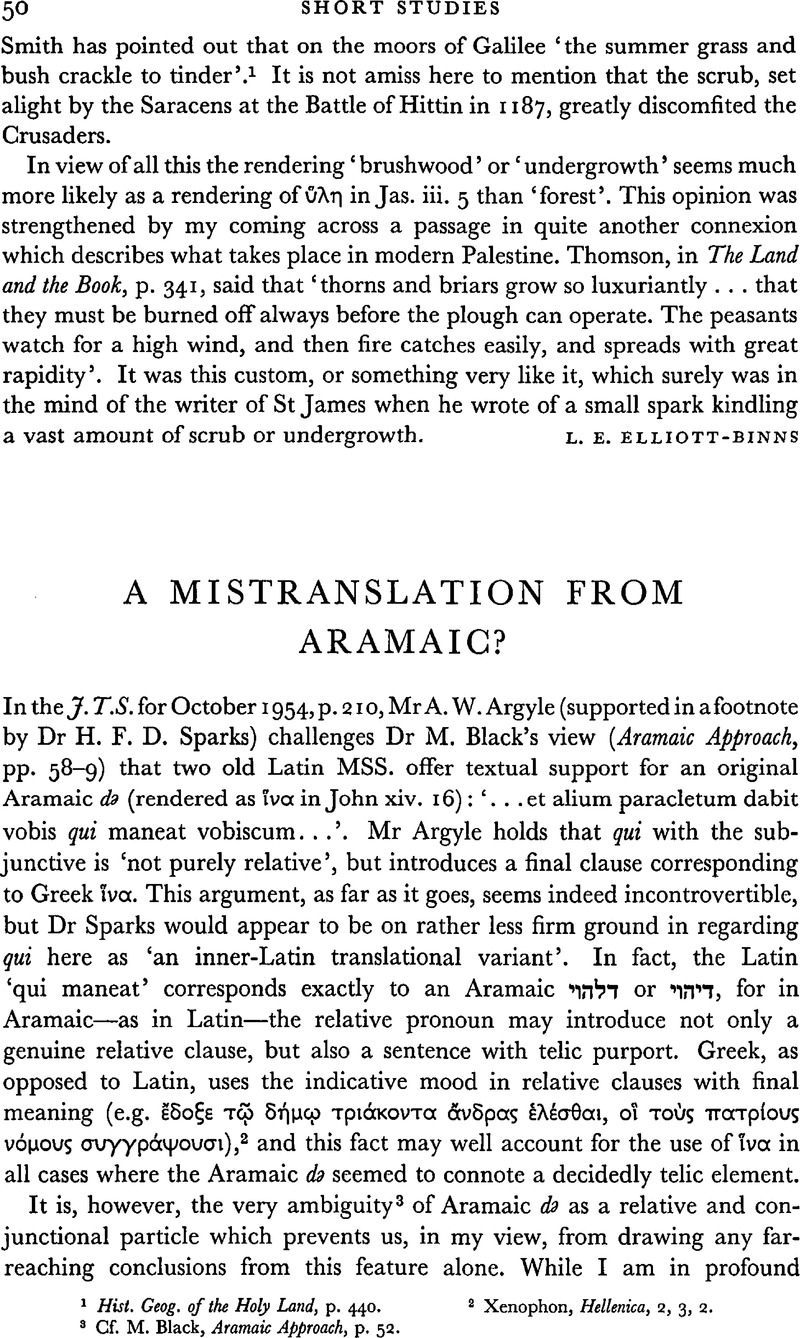Article contents
A Mistranslation from Aramaic?
Published online by Cambridge University Press: 05 February 2009
Abstract

- Type
- Short Studies
- Information
- Copyright
- Copyright Cambridge University Press 1955
References
page 50 note 1 Hist. Geog. of the Holy Land, p. 440.
page 50 note 2 Xenophon, Hellenica, 2, 3, 2.
page 50 note 3 Cf. Black, M., Aramaic Approach, p. 52.Google Scholar
page 51 note 1 I would, in fact, go further and call it the Semitic approach, for late Hebrew (in the form soon to be reflected in the language of the Mishnah) must not be excluded, but in the present case the same considerations apply to Hebrew ![]() as bear upon Aram. d.
as bear upon Aram. d.
page 51 note 2 Einleitung in die drei ersten Evangelien (1911).
page 51 note 3 The Aramaic Origin of the Fourth Gospel (1922).
page 51 note 4 Cf. the observations on mistranslation in M. Black's Aramaic Approach, pp. 6ff. (et passim).
page 51 note 5 I am limiting myself to these two aspects, but d may have other meaning variants as well; see op. cit. ch. iv.
page 51 note 6 Cf. Segal, , Grammar of Mishnaic Hebrew, p. 234. This and the following quotations are from the 1936 Hebrew ed. of Segal's work which is an enlarged and improved version of the English ed.Google Scholar
page 52 note 1 See Segal, op. cit. pp. 123, 154.
page 52 note 2 See Dalman, Gramm. d. jd.-pal. Aram. (1894), 61.
page 52 note 3 Gramm. d. Bibl.-Aram. p. 131.
page 52 note 4 Gramm. d. Christ.-Pal. Aram. p. 57.
page 52 note 5 Lehrbuch d. Aram. Spr. d. Bab. Talmud, p. 95.
page 53 note 1 Cf. Bruce, F. F., The Acts of the Apostles, pp. 1901; R. B. Rackham, The Acts of the Apostles, p. 122.Google Scholar
page 53 note 2 See esp, Sir Henry Yule's excellent article Prester John in the Encyclopaedia Britannica13. Cf. also Ullendorff, E., Exploration and Study of Abyssinia, p. 13, and Alvarez, Portuguese Embassy to Abyssinia, ch. LVIII et seqq. (transl. by Lord Stanley of Alderley, Hakluyt Society, 1881).Google Scholar
page 53 note 3 Cf. SirBudge, E. A. W., History of Ethiopia, vol. I, pp. 11314.Google Scholar
page 53 note 4 Cf. the Silko inscription (Dittenberger, Inscriptiones selectae, vol. I, p. 303).Google Scholar
page 54 note 1 goes clearly back to a Semitic idiom (as has indeed been pointed out by Black, M., Aramaic Approach, p. 68) such as ![]() Cf. also
Cf. also ![]() (Kebra Nagast, ch. 21);
(Kebra Nagast, ch. 21); ![]() (Arabic version of Queen of Sheba legend, ed C. Bezold, Abhandl. d. K. Akad. d. Wissensch., Munich, 1905, p. xlv), etc. The possibility of
(Arabic version of Queen of Sheba legend, ed C. Bezold, Abhandl. d. K. Akad. d. Wissensch., Munich, 1905, p. xlv), etc. The possibility of ![]() being a metathetical corruption of
being a metathetical corruption of ![]() cannot be excluded (despite Mehri haziebJahn, Mehri Sprache, p. 262). The Arabic
cannot be excluded (despite Mehri haziebJahn, Mehri Sprache, p. 262). The Arabic ![]() is, of course, a loan-word from Ethiopicas had already been shown by Nldeke, Neue Beitrge, pp. 623. Incidentally, the phrase , occurring in both Matt. xii. 42 and Luke xi. 31, reflects in all probability a Semitic
is, of course, a loan-word from Ethiopicas had already been shown by Nldeke, Neue Beitrge, pp. 623. Incidentally, the phrase , occurring in both Matt. xii. 42 and Luke xi. 31, reflects in all probability a Semitic ![]() .Google Scholar
.Google Scholar
page 54 note 2 The translated extracts in the following are based on the Ethiopic text of Bodleian MS. Bruce 93 and Bezold, op. cit. Another important passage revealing the full extent of the confusion is in chapter 34 where King Solomon's people ask Menelik's retinue about their country of origin, and they reply: We have come from the provinces of Hendake (Candace) and Ethiopia.
page 54 note 3 The anachronistic treatment of pre-Christian events is, of course, best known from the versions of the Alexander legends which have all been given a Christian character, and Alexander himself is depicted as a devout Christian. Cf. the remarks in the present writer's Exploration and Study, p. 42.Google Scholar
page 54 note 4 The present brief note is not meant to investigate the provenance and development of this cycle of legends. Attention might, however, be invited here to a particularly interesting version of this story depicted in a window of King's College Chapel, Cambridge, which recently was the subject of a learned article in The Times of 28 June 1954.
page 55 note 1 See Littmann, , Aksum Expedition, vol. iv, passim; also my notes in Africa (1949), pp. 612, and in J.R.A.S (1951), p. 27.Google Scholar
page 55 note 2 SirBudge, E. A. W. (Queen of Sheba and her son Menyelek, p. viii) sees an even earlier type of this legend in the meeting of Gilgamesh with Siduri, the inn-keeper (cf. Gressmann, Altorient. Texte z. A. T. pp. 170 ff.), but the resemblances seem to me very slight indeed.Google Scholar
page 55 note 3 See especially the beginning of p. 117 of Budge's edition of the Ethiopic version of the Life and Exploits of Alexander the Great, vol. I.Google Scholar
- 1
- Cited by


